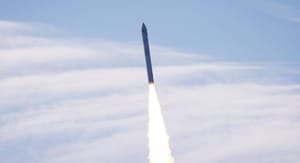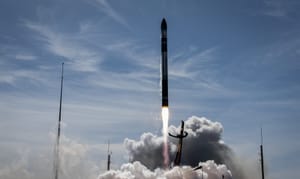
Dec 23, 2023
ULA gears up for Vulcan's maiden flight
United Launch Alliance is currently preparing to launch its Vulcan rocket on its maiden flight currently scheduled for the 8th of January 2024. This flight is also carrying the Astrobotic Peregrine lunar lander for Astrobotic's first lunar landing mission.
As of the 20th of December 2023, the Vulcan rocket is fully stacked on the launch pad. This includes the first-stage, second-stage, two solid rocket boosters, and payload encapsulated in a fairing.
United Launch Alliance has been developing Vulcan since 2015 to replace its Delta IV Heavy and Atlas V rockets while being more capable and affordable.
What led the way to Vulcan's maiden launch?
On the 12th of February 2021, Vulcan's 'Pathfinding Tanking Test' booster arrived in Cape Canaveral, Florida. Months later on the 5th of October 2021, the 'Pathfinding Tanking Test' booster was filled with liquid methane and liquid oxygen during testing at Space Launch Complex 41.

On the 16th of October 2022, the two GEM-63XL solid rocket boosters manufactured by Northrop Grumman were delivered to Cape Canaveral ahead of stacking of the rocket.
On the 22nd of January 2023, Vulcan's first-stage, Centaur second-stage, and interstage adapter arrived at Cape Canaveral ahead of further testing. Two months later on the 16th of March 2023, Vulcan's first and second stages were filled with their propellants during a cryogenic fuelling test.
On the 7th of June 2023, Vulcan's first-stage completed a Flight Readiness Firing with its two BE-4 engines at Space Launch Complex 41. The two BE-4 engines fired as planned for six seconds.

On the 8th of December 2023, Vulcan and its Centaur upper stage underwent a wet dress rehearsal which revealed ground system issues according to Tory Bruno, Chief Executive Officer of United Launch Alliance. This required the rocket to be rolled back from the pad.
On the 12th of December 2023, the rocket once again went through a wet dress rehearsal but this time managed to successfully complete the test.
And finally, on the 20th of December 2023 the payload, encapsulated in the faring was lifted onto and attached to the top of the rocket.

United Launch Alliance is currently targeting the 8th of January 2024 at 02:18 am Eastern Standard Time for Vulcan's maiden launch in the VC2S configuration. The VC2S configuration is the Vulcan-Centaur rocket augmented with two GEM-63XL solid rocket boosters.
What is the Vulcan rocket?
Vulcan, sometimes called Vulcan-Centaur, is United Launch Alliance's in-development two-stage rocket. Vulcan is planned to replace the company's Atlas V and Delta IV Heavy launch vehicles in the coming decade.
The first-stage is powered by two BE-4 engines generating 500 tons of thrust burning liquid methane and liquid oxygen for four minutes and fifty-nine seconds. The BE-4 engines are manufactured by Blue Origin for use with United Launch Alliance as well as Blue Origin's upcoming New Glenn rocket.
The second-stage is powered by two RL-10 engines generating 22 tons of thrust burning liquid hydrogen and liquid oxygen for a currently undisclosed amount of time. The RL-10 engines are manufactured by Aerojet Rocketdyne for use with United Launch Alliance.
Vulcan can also launch with either zero, two, four, or six GEM-63XL solid rocket motors to augment the rockets thrust and capabilities. Each booster burns a solid propellant, consisting of Hydroxyl-terminated polybutadiene and Aluminum-Ammonium perchlorate, generating 224 tons of thrust each for a believed one minute and fifty seconds. The solid rocket boosters are manufactured by Northrop Grumman for use with United Launch Alliance.
In the table below, United Launch Alliance claims Vulcan can deliver the following amount of payload in its four potential configurations.
| Vulcan Centaur VC0 | 10,800 kilograms to low Earth orbit, 3,500 kilograms to geosynchronous transfer orbit, or 2,300 kilograms to a trans-lunar injection |
| Vulcan Centaur VC2 | 19,000 kilograms to low Earth orbit, 8,400 kilograms to geosynchronous transfer orbit, or 6,300 kilograms to a trans-lunar injection |
| Vulcan Centaur VC4 | 24,600 kilograms to low Earth orbit, 11,700 kilograms to geosynchronous transfer orbit, or 9,200 kilograms to a trans-lunar injection |
| Vulcan Centaur VC6 | 27,200 kilograms to low Earth orbit, 15,300 kilograms to geosynchronous transfer orbit, or 12,100 kilograms to a trans-lunar injection |
The naming scheme of each Vulcan configuration is as follows: V stands for Vulcan, C stands for Centaur, 0/2/4/6 stands for the amount of solid rocket motors, and S/L stands for the payload fairing length. For example, Dream Chaser would use the VC4L configuration and Astrobotic's Peregrine lunar lander would use the VC2S configuration.
Who is United Launch Alliance?
United Launch Alliance is an American aerospace company founded in December of 2006 as a joint venture between Lockheed Martin and Boeing. The company currently operates the Delta IV Heavy and Atlas V launch vehicles.
United Launch Alliance is currently developing the Vulcan rocket with an expected maiden flight in January of 2024.




